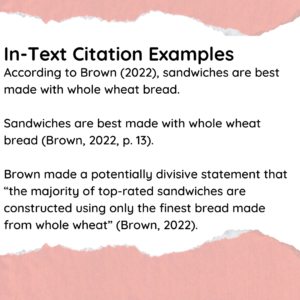Chapter 2: Citing Sources
By the end of this chapter, you should be able to:
- Demonstrate ability to cite sources in APA Style Format. (LO4)
- Examine strategies for maintaining academic integrity. (LO5)
Test Yourself
Complete this pre-test to see what you know already about citations. Then, review the following content to identify more strategies for maintaining academic integrity.
Citations Continued
Citations are formatted in specific ways, depending on the style being used. For this textbook, we are only going to use APA Style. But MLA is another popular option (and there are many more!). In-text citation for APA Style should at minimum include the author(s) and year of publication. It is recommended to include a page range, so the reader can more easily refer to it, but it is not required. Here’s some examples of in-text citation:
Citations can be summaries, paraphrases, or direct quotations. Summaries are when you provide a brief overview of what the source material provided. Paraphrases are when you restate the ideas from the source using your own words and style. And direct quotes are exactly that: direct quotes. Can you look at the examples above and determine which kind of in-text citation it is?
References
Regardless of citation style (e.g. APA, MLA, etc.), there should be a hanging indent. The hanging indent leaves the beginning of the citation at the far left of the document and then each line after the the first is indented. To do this in Microsoft Word follow these steps:
- Highlight the citation information
- From the Home Tab, select the bottom-right hand arrow in the paragraph menu (Keyboard short cut for highlighted text: Control + t)
- Or, if you prefer to use a drop-down menu, highlight text and go to “Home” then “Paragraph”.
- Select the “Indents and Spacing” tab. Under “Special” select the drop down menu and change to “Hanging”.
- Select “Okay” to save these settings.
References for Remixed Content:
American Psychological Association (2022). Style and grammar guidelines. APA Style. https://apastyle.apa.org/style-grammar-guidelines
PALNI (2022, June 3). Understanding plagiarism and citing sources. PALNI Information Literacy Modules. https://libguides.palni.edu/instruction_resources/ILModule11
Purdue Online Writing Lab (2022). General format. Purdue OWL. https://owl.purdue.edu/owl/research_and_citation/apa_style/apa_formatting_and_style_guide/general_format.html


